When you understand the true size of the real world, it’s obvious how little one can actually include in model form. Just to nail the point again: in 1:48, my 15-inch wide by 96-inch long cameo is only 60 x 384 scale feet and that’s just fine by me. With this project I’m experimenting with ideas of minimum compression that have been stirring in my head for some time.
The central question is what do I want to see and experience on this layout? As iconic as the image of a single car at a small town siding is, my current experiences are of long strings of cars being sorted into spot order with the most interesting action taking place in a very small area. From these observations, I believe one or two turnouts with appropriate lengths of track coming off them can provide more than enough operation for my tastes.
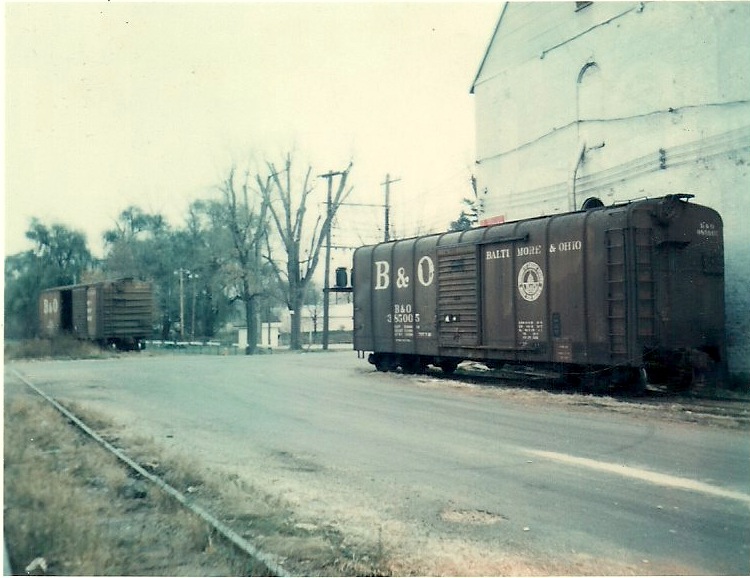
Boxcars at a grain elevator are a model railroad icon.
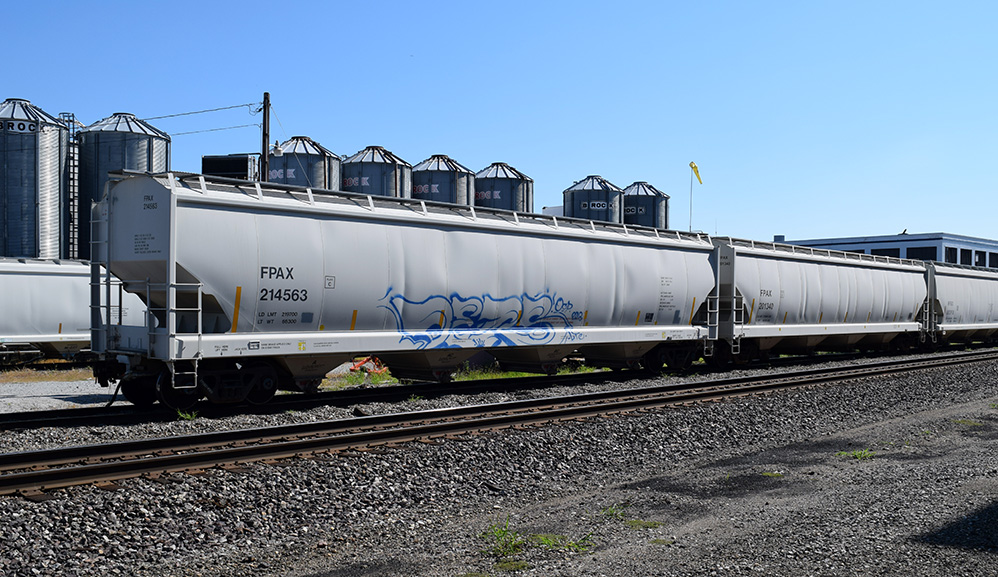
My railfan images also include sorting out long cuts of cars.
Back To Basics
With this project I’ve returned to my roots by modeling a rural setting. The non-specific Indiana location is mundane and ordinary with only the railroad, a grade crossing and the surrounding vegetation. While that may sound boring, there is plenty to keep your attention here. It’s a hazy overcast day that obscures the fields and tree line in the background. Look closely around the tracks and you’ll find remnants of the past but they’re slowly moldering away into the landscape. This crossing at Mill Road is a perfect front row spot to watch the local work back and forth sorting out a long string of cars for the elevator.
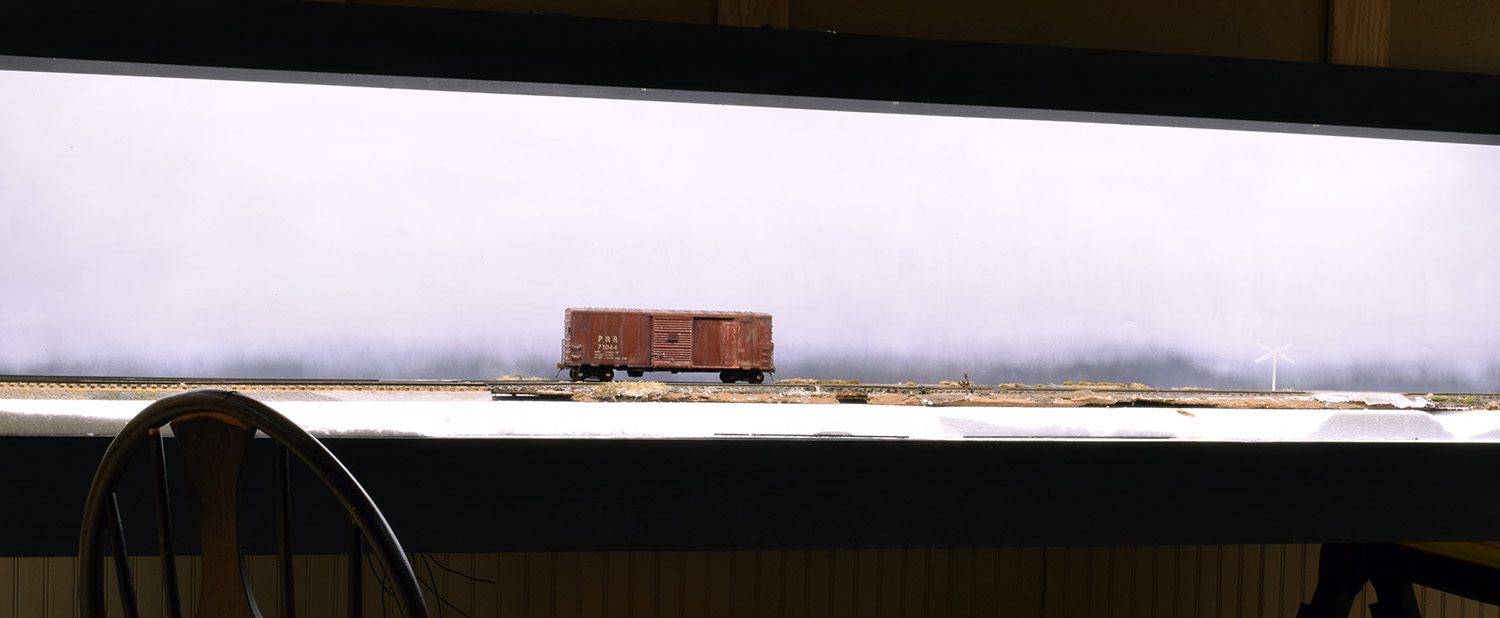
I temporarily placed the cameo on sawhorses so I can sit comfortably to finish up the track work. The backdrop is a sheet of aluminum flashing stock that I painted with spray cans. The fascia is a charcoal gray that frames the modeling nicely. Low profile LED strip lights provide the illumination. The cord is hidden in the rear corner.
The cameo is more like a well-composed photo than what we think of as a traditional layout. Contrary to what most believe, with only eight feet of modeled track and scenery, there is little reason to compress anything. A key with a design like this is to focus on a single feature, in this case the right-of-way, and let it speak with a clear voice. By eliminating non-essentials, the scene can breathe and the imagination can stretch its legs.
With staging included, the entire layout will be 24 feet long; the same as the old one but it feels much smaller because only one third has scenery. The staging areas are painted the same charcoal gray as the cameo and should not draw your attention even though they are in plain sight. Instead your eyes will be drawn to the light, colors and visual texture of the scene at Mill Road.
Imagination Fills In The Gaps
To switch a long cut of cars requires a fair amount of track. Since I have to use the space anyway, why not include one or both staging areas as part of the scenery? Doing that would destroy the illusion of a train coming and going. It’s a mistake I made with the old layout and it’s a realism killer. If the finished scenery goes from here to there and we can always see the train, that determines our perception of how big this world is. However, if the train can disappear from view, or at least seem to, then our imagination has someplace to go.
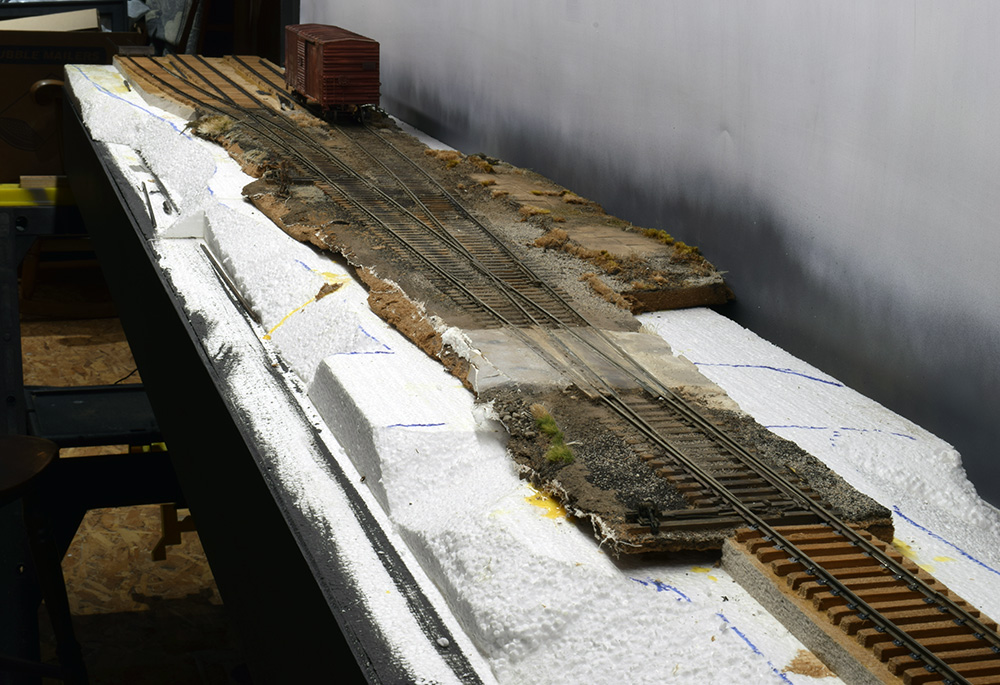
You all wanted a track plan, well here it is. I salvaged the turnouts and crossing from the old layout and it feels good to put them back in service. You’re looking at the entire scene. The surrounding scenery will be mostly ground cover and a few select tree models. Transitions to staging at both ends will be quite simple. The boxcar sitting on the elevator track gives a sense of scale.
On the left end of the scene, I have three tracks. The center track is the running line that extends the length of the layout into both staging areas. This lets me simulate through movements from off stage locations, such as a light engine on its way to pick up cars at an interchange. Later, the engine returns with those cars and works the elevator. When the work is done, he can leave the same way or continue further up the line back to the other staging track on the opposite end.
Staging also plays an important role in working the elevator. The track nearest the backdrop is the loading track. Once it enters the staging, this track is long enough to store a number of cars. The pretense is they have been positioned beyond the nonexistent grain elevator, loaded one by one and moved forward to make room for the next one in line. In reality, they will just sit there until the next session when I reposition them for pickup. Depending on how many are spotted, the loads may span the threshold between on stage and off, strengthening the illusion of unseen activity and the passage of time.
I think there is something important here to consider. When the engine shoves the empty cars down this track it will leave the scenicked area completely. As a railfan, I don’t have to see where the train goes or how far. My imagination can fill in the missing details and in doing so the scope of the layout is greatly expanded from one where everything happens in plain sight, to one that is a just a segment of a much larger world.
The third track is general storage for off spot cars waiting their turn for loading or that just need a place to go. I could also spot loaded grain cars here for later pickup by another train. This track uses the same principles just outlined.
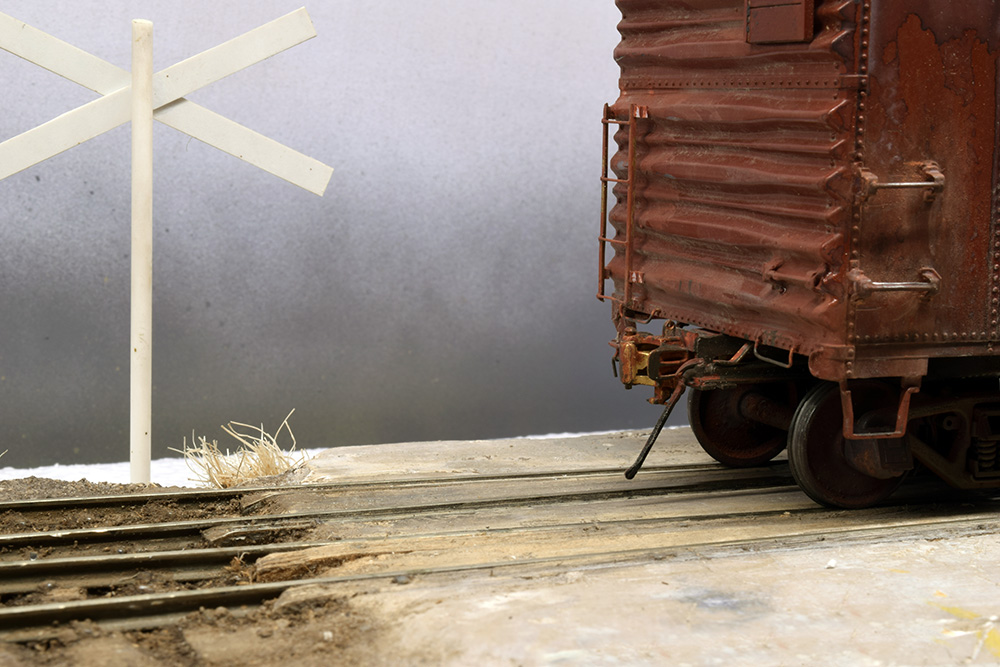
This is how the scene looks closer to the normal viewing position. I’m still reflecting on the treatment of the backdrop. I believe it needs to be quite simple and carefully blending the colors is critical to a seamless transition from the 3D foreground. From this perspective, the lack of depth isn’t that apparent to my eyes.
With this cameo, I can represent through movements and switching cars at a customer large enough to justify rail service with a minimum of visual compromises. I’m nearly finished with the track and will soon move on to ground cover and look at how to gracefully enter and exit the scene. Sounds like a plan and it only took me forty years to figure it out.
This style of layout is quite common in other parts of the world. With our basement empire mentality and having the notion that space is a terrible thing to waste drilled into our heads for thirty years, we simply don’t consider options like this. We see them as a second rate last resort rather than a deliberate first choice. I believe it’s important to understand that such design concepts make a scale like quarter-inch or 1:64 possible for a wider array of room sizes and personal budgets. While the basement empire dream is something many still aspire to, this craft offers so much more.
Regards,
Mike
Mike,
You really have some interesting ideas and I enjoy your posts. I am a little confused. Are the cars on the elevator track loaded or unloaded. In other words does the locomotive push them down towards the un-modeled elevator or pull them off the scenic part to the right. This whole concept of not having to see the locomotive as it does it’s work has really opened my eyes to some interesting ideas. Thanks.
John
Hi John,
The elevator track continues from the turnout with the crossing onto the three track staging cassette, which I’m thinking will be eight feet long. A locomotive will shove a cut of empty cars the length of this track, leaving the scene in the process. Prior to the next session, the same cars will be restaged on the same track but closer to the transition between staging and the scenicked portion. At this point they are assumed to be loaded and ready for pickup. It’s confusing to describe with words, so in the next post I will include a schematic that should help people envision the process. It’s actually quite simple.
Regards,
Mike
This latest effort holds much intrigue! It reminds me of Kelvin White’s Finistere layout design, especially in the way you intend to carry operation “beyond the layout”. I’m interested to see how you disguise the exits to the modeled scene while maintaining the open feel.
Have you seen what Trevor Marshall did for a backdrop? I think his approach might work well with what you have planned. I almost think what you have is already to distracting to the eye. Trevor’s approach was an eye opener, and follows your thought process of “let the imagination fill in the gaps” process.
If you ever want to switch era’s, or locations your approach makes this quite easy. Swap boxcars for covered hoppers. Covered hoppers for tanks, etc.
Craig
Hi Craig,
I’m aware of Trevor’s approach. The backdrop will look quite different once I get rid of all the bare styrofoam and add more texture and color to the foreground scenery. I could not only change eras and rolling stock but industries too.
Mike
Once again you boldly go forward with a minimal approach that is nothing short of telling a story, but rather focus on it to bring forward certain qualities that matter to you. This sentence “As a railfan, I don’t have to see where the train goes or how far.” rings a bell with me since the more I design layouts, the more it comes to my mind I’m happy standing in one point and being spectator of a show far bigger than me. It seems to me your recent efforts at framing scenes have a lot to do with our effective field of vision. As you are aware, I’m actually in the process of implementing these cameo layout principles onto a larger HO scale layout and it’s fun to see that ones can indeed take two turnouts in the middle of barren fields and call it a sucessful endeavour.
Thanks for your answer Mike, I get it. Didn’t a lot of elevators handle other things like coal? Operational interest could be added by sticking a coal hopper in the mix that might not be where it needed to be in the string of incoming cars. This would add a little shuffling of cars before shoving them onto the arrival track.
John
Hello, Mike.
I love the work you’re doing.
You could try a black velvet backdrop. I have this on my n-scale switching layout. It’s not traditional as backdrops go, but it is effective, non-distracting, and allows one’s imagination to fill in the details. It will make the layout kind of like reading the book instead of seeing the movie. I wrote about this in the Layout Design SIG journal (LDJ #61) that just came out. I can send pictures if you are interested.
Hi Jonathan,
That is an unusual choice of materials for certain. How do you keep it clean from lint and other stuff? Yes, I’d like to see photos.
Mike
Mike,
I don’t feel this is important to you, but I thought it might be interesting to get a feel for the operational potential of such a layout plan. My soon to be dismantled layout has three tracks where I can simulate the plan. I had four box cars on the elevator spur to be picked up. There was another one on the holding track. The incoming train had three boxcars and a coal hopper. From the engine the coal hopper was the second car. I imagined beyond the elevator was a coal track, so the hopper had to be the first car in the string pushed onto the spur. The three boxcars in the train and the one on the spur would be after the hopper in no particular order. Counting a change of direction, or stop to couple/uncouple as a move it took me 18 moves, 50 minutes. I was switching using a ProtoThrottle, mostly in notch 1. Later I measured the speed at notch 1 and came up with 3mph, notch 2 which looked fast to me was at 9mph, so switching in notch 2 would probably be prototypical and cut the time down. But if running a layout 15-30 minutes is the goal this layout does the trick.
John
Thanks for sharing this John. It confirms the potential of the design and your scenario is how I plan to use the layout.
I’ve noticed when the local pulls or shoves a long cut, he moves a little quicker. Sorting out cars into spot order the speed is slower and more controlled, since the crewman has to move in to align switch points, work uncoupling levers, open/close retainers, set brakes and so on. It’s one of those nuances of running model railroaders tend to ignore.
Mike
Thank you Matt. I’m following the evolution of your layout with great interest.
Mike
Hi Rhett,
Thanks for the kind words. Those topics are coming.
Mike
As always, thank you for your insightful, expressive blog post. I’ve ended up with something similar to your cameo, though taken to a personal extreme.
Most of my views of the prototype are static. Freight cars on a siding along the road where I walk. Although I occasionally see a train go by, or a local shunt cars, those times pale against the quiet atmosphere of cars left on a siding.
This has led me over the years to a sense of abstraction. I agree with your observation that with a model, light that fades to the sides of the central scene enhances imagination. It’s akin to a theater stage where there are no sharp curtains from where actors appear, and where the stage has only minimal props and backdrop. The focus is on the play as it unfolds both in script and in the audience’s mind.
So where has this led me? As I said, to an abstraction. A narrow shelf with a short length and height of black cardstock against a sheetrock wall behind, enough to frame just a couple of cars (the short black backdrop enhances the focus). This small scene is lit with diffuse light at 35 degrees to the vertical that drops gently to the sides. There are just two tracks. Only the cars against the short backdrop take center stage. Other cars are supporting actors.
Occasionally I do run an engine, just to say I can. But honestly I hardly enjoy doing so. Instead it is the simple presence of the scene that lifts my spirit. An abstraction. An icon.
Hi Bill,
Your story simply illustrates how many ways there are to enjoy the craft.
Mike